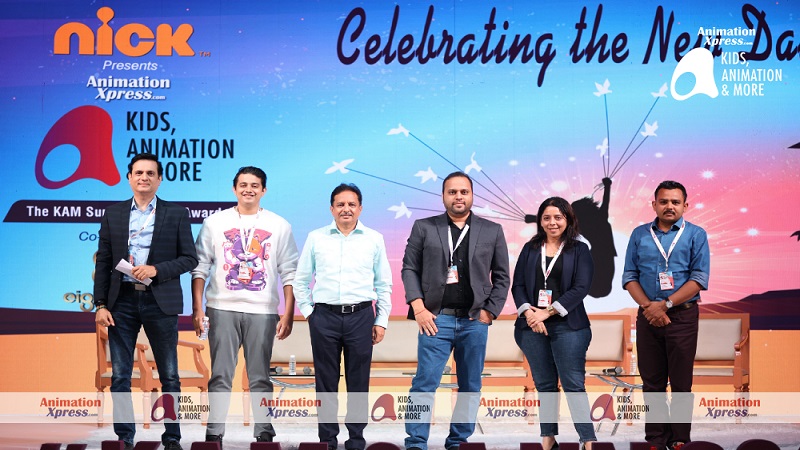Animation Xpress’ Kids Animation & More (KAM) Summit and ANN Awards 2022 had an amazing lineup of power-packed panel discussions centered on the animation industry. The engrossing panel discussion on the topic ‘Building a Complete Animation Monetisation Ecosystem’ mainly dwelt upon Intellectual Property (IP) creation, strategizing, focusing on the monetisation ecosystem at the planning stage and learning how to exploit various avenues to monetise ones creation to make it big.
The panelists included Toonz Media Group Distribution and Syndication, India country head Murtuza Kutianwalla, Green Gold Animation chief strategy officer Srinivas Chilakalapudi, Digitoonz founder and CEO Vikas Kumar, Black White Orange CEO and founder Mitali Desai and Videogyan CEO and founder Vishal T M. The discussion was moderated by Powerkids Entertainment CEO Manoj Mishra.
While talking about Indian IPs in the animation industry Chhota Bheem is the name that everyone would recognize. The IP was created by Green Gold Animation CEO Rajiv Chilaka for Pogo which went on air in 2008. Very soon it became popular and the team started producing comics, t-shirts and merchandise. They invested and backed their own show.
“In 2010, we started doing licensing and tied up with some brands. In 2012, the big push came when we did our first theatrical movie Chhota Bheem and the Curse of Damyaan. We took the risk and at that time the movie did well. We ended up signing 10-15 licensing partners, added to existing merchandising. Parallely, we launched our YouTube channel, which took off. We also entered into Apps and Gaming. Our movie game Chhota Bheem Shoot the Leyaks did so well that it was taken as a study by Google,” Chilakalapudi said.
“The original show created the other monetisation avenues, which created more new shows and those were monetised again,” he pointed out.
Moving on to co-productions, Mishra wanted Murtuza to explain the approach of Toonz Media Group. The distribution head explained that one needs to have a strong collaborative approach when you intend to work with someone else’s IP.
“Co-production is much more in our ecosystem because we are open to new IPs by new developers and also open to working with large organisations where we would like to add some value. The idea is not to restrict our territories and use their strengths and our strength to mold it into a larger business. I think that’s the main intention,” Murtuza.
According to him, creating an IP can be as small as a five page presentation that can be executed. If the vision is really big, there is heart and soul in it, his organisation would be interested in hearing it out and adding value to it.
Moving further, Videogyan, which is a new-age media studio producing kids’ content, follows a digital platform based monetization model. Their animated videos such as nursery rhymes and cartoon shows are available on their YouTube channel and they have also monetised the audio of their shows which are available on Spotify, Prime music and so on.

Suggesting the idea that Indian brands should learn from the seriousness with which the international brands take the entire monetisation ecosystem while creating an IP, Desai said, “The ecosystem cannot be an afterthought. It’s not only about the core, the content, it’s about what more can you do around the brand and that needs to be done at the planning stage. The vision actually happens at that seeding stage itself.”
She gave an example of working with the Baahubali team who actually integrated the entire ecosystem at the planning stage and that is very important.
Talking about the major difference noticed while producing content for international market versus Indian market, Vikas directly pointed out that it is the ‘budget’.
“If we have a good budget, I think the entire ecosystem can be enhanced,” he said. The story and design can be more appealing with a good budget. The positive thing is that the Indian market is moving in that direction.
Asked if having one’s own AVOD platform creates a clash with the broadcasters and if they allow them to bifurcate the rights like this, Murtuza said, “I think the rights management and the way rights work with broadcasters and specially players who have been in the market, it is very clearly bifurcated and they understand what they are buying the rights for and what it is going to be exploited for.”
“I think the sensibility to bifurcate your rights and then selling the right amount of rights to the right player is extremely important. And that starts at the strategy level,” he added.
Chilakalapudi explains that giving away IP rights to the leading broadcasters and OTT players, is all about negotiation. Based on your strength you can hold some of the rights and give away the ones you feel you are not really good at. He advises the new studios that it is a give and take relation; hence they should keep few rights only if they feel they are strong at it. For example, if they have manufacturing capability, they can keep merchandising.
Mishra mentions that the key takeaway of the discussion of KAM Summit 2022 is that if one has a good IP or good content, if you are at the right place and your distribution mechanism is right, if you have a good concept from the beginning along with good style guide, then you can approach the broadcasters and monetise your IP on a global basis.


